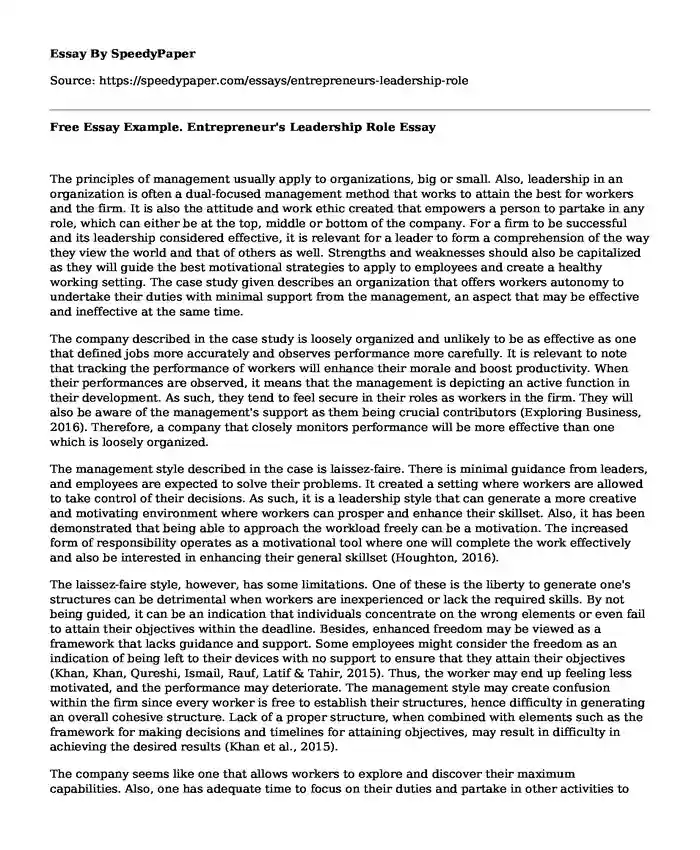
| Type of paper: | Essay |
| Categories: | Human resources Organizational culture Leadership style Leadership management |
| Pages: | 3 |
| Wordcount: | 771 words |
The principles of management usually apply to organizations, big or small. Also, leadership in an organization is often a dual-focused management method that works to attain the best for workers and the firm. It is also the attitude and work ethic created that empowers a person to partake in any role, which can either be at the top, middle or bottom of the company. For a firm to be successful and its leadership considered effective, it is relevant for a leader to form a comprehension of the way they view the world and that of others as well. Strengths and weaknesses should also be capitalized as they will guide the best motivational strategies to apply to employees and create a healthy working setting. The case study given describes an organization that offers workers autonomy to undertake their duties with minimal support from the management, an aspect that may be effective and ineffective at the same time.
The company described in the case study is loosely organized and unlikely to be as effective as one that defined jobs more accurately and observes performance more carefully. It is relevant to note that tracking the performance of workers will enhance their morale and boost productivity. When their performances are observed, it means that the management is depicting an active function in their development. As such, they tend to feel secure in their roles as workers in the firm. They will also be aware of the management's support as them being crucial contributors (Exploring Business, 2016). Therefore, a company that closely monitors performance will be more effective than one which is loosely organized.
The management style described in the case is laissez-faire. There is minimal guidance from leaders, and employees are expected to solve their problems. It created a setting where workers are allowed to take control of their decisions. As such, it is a leadership style that can generate a more creative and motivating environment where workers can prosper and enhance their skillset. Also, it has been demonstrated that being able to approach the workload freely can be a motivation. The increased form of responsibility operates as a motivational tool where one will complete the work effectively and also be interested in enhancing their general skillset (Houghton, 2016).
The laissez-faire style, however, has some limitations. One of these is the liberty to generate one's structures can be detrimental when workers are inexperienced or lack the required skills. By not being guided, it can be an indication that individuals concentrate on the wrong elements or even fail to attain their objectives within the deadline. Besides, enhanced freedom may be viewed as a framework that lacks guidance and support. Some employees might consider the freedom as an indication of being left to their devices with no support to ensure that they attain their objectives (Khan, Khan, Qureshi, Ismail, Rauf, Latif & Tahir, 2015). Thus, the worker may end up feeling less motivated, and the performance may deteriorate. The management style may create confusion within the firm since every worker is free to establish their structures, hence difficulty in generating an overall cohesive structure. Lack of a proper structure, when combined with elements such as the framework for making decisions and timelines for attaining objectives, may result in difficulty in achieving the desired results (Khan et al., 2015).
The company seems like one that allows workers to explore and discover their maximum capabilities. Also, one has adequate time to focus on their duties and partake in other activities to boost their careers, such as pursuing a course or even engaging in research aligned with their roles or responsibilities. Therefore, it may be quite interesting to work for this company.
The firm in the case study is one that has a loose form of organization and thus likely to be ineffective. Workers' performance is not closely monitored. The management style is laissez-faire due to minimal guidance from leaders, and employees have a chance to solve their issues. It may end up creating a more innovative and motivating environment where employees can prosper and improve their skillset. However, by not guiding workers, they can end up concentrating on the wrong activities or even fail to achieve their goals within the set deadline. Workers may take advantage when working in this firm to enhance their knowledge and skills once they have completed their duties.
References
Exploring Business. (2016). University of Minnesota Libraries Publishing edition.Houghton, M. (2016). IGCSE and O-level business studies. Cambridge University Press.
Khan, M. S., Khan, I., Qureshi, Q. A., Ismail, H. M., Rauf, H., Latif, A., & Tahir, M. (2015). The styles of leadership: A critical review. Public Policy and Administration Research, 5(3), 87-92.
Cite this page
Free Essay Example. Entrepreneur's Leadership Role. (2023, Apr 05). Retrieved from https://speedypaper.com/essays/entrepreneurs-leadership-role
Request Removal
If you are the original author of this essay and no longer wish to have it published on the SpeedyPaper website, please click below to request its removal:
- HRM Essay Example on the Five Dysfunctions of a Team
- PTSD and the Use of the Drug Oxytocin for Treatment, Free Essay on Mental Disorder
- Response Essay Example: Would Football without Concussions Still be Football?
- Essay Sample for Students: Intercultural Training and Effectiveness
- Free Essay: Sociology of the Families - The Help
- Essay Sample on Land Use in Michigan
- Free Essay Sample on Moral Leadership
Popular categories




